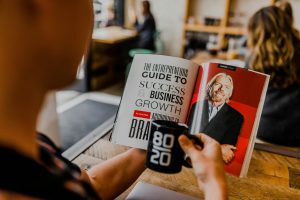8. Developing a Portfolio
Learning Objectives
In this chapter, you will learn how to:
- develop a professional portfolio that effectively showcases your capabilities and achievements while building your reputation in your chosen field
- select and organise compelling evidence of your professional capabilities that aligns with industry expectations and demonstrates your readiness for practice
- implement systematic approaches to gathering, documenting, and presenting evidence of your growing professional competence throughout your career development.
Imagine this Scenario
Marley sat in her university’s cafe, barely touching her lunch as she stared at the email on her phone, a job offer from the prestigious Anderson Marine Research Centre. The position would place her directly under Dr Bernice Guest, whose groundbreaking work on endangered marine species had featured in multiple documentaries. Dr Guest’s recent discovery of what might be the last colony of Java stingrays had made international headlines, and her lab consistently secured major government research grants.
“I got the job!” Marley announced to Professor Chen during their next project meeting. Rather than sharing her excitement, Professor Chen’s smile seemed strained. She congratulated Marley politely but quickly changed the subject. The same thing happened with Professor Roberts, another oddly muted response to what Marley considered incredible news.
Later that week, over coffee with her friend Jade, Marley mentioned these puzzling reactions. Jade’s face fell. “Oh Marley Dr Guest has a terrible reputation as a supervisor. Everyone in marine biology knows about it.”
Concerned, Marley sought out her professors again, this time asking directly about Dr Guest. Professor Chen hesitated before speaking. “I’ve never met her personally, but I’ve heard concerning stories from multiple colleagues. Her students and staff often leave within months, usually quite distressed.” Professor Roberts nodded in agreement, adding that while Dr Guest’s research output was impressive, her lab had an unusually high turnover rate.
Looking at Dr Guest’s professional profile, Marley saw an impressive list of achievements, numerous publications in top journals, successful grant applications, groundbreaking discoveries. Surely the opportunity to work with someone so accomplished outweighed any potential workplace challenges? Despite the warnings, Marley accepted the position.

Six months later, Marley barely recognised herself. The enthusiastic graduate who had eagerly joined the lab had been replaced by someone who struggled to get out of bed each morning. Dr Guest’s demanding and erratic management style meant Marley never knew when she would be praised or berated. Weekends became meaningless as she was expected to be available at all hours. The constant stress led to panic attacks, and Marley found herself experiencing severe anxiety about even routine workplace interactions.
The irony wasn’t lost on Marley, she had focused entirely on Dr Guest’s documented achievements while dismissing the undocumented but crucial evidence about her reputation as an employer. This painful experience taught her that professional portfolios tell only part of the story, and that reputation and workplace relationships matter just as much as technical achievements.
Building a Reputation
Professional reputation develops through three interconnected channels that each provide different perspectives on someone’s capabilities and character.
Public Profiles
Include published work, social media presence, and formal achievements, and offer a curated view of professional accomplishments that can be easily verified. For instance, Dr Guest’s impressive publication record and research discoveries represented the public face of her reputation.
Private Experiences
These reveal how someone actually operates in day-to-day professional settings, their management style, communication approach, and treatment of colleagues. These experiences often remain hidden from public view but profoundly impact workplace relationships and team dynamics, as Marley discovered through her distressing time in Dr Guest’s lab.
Word of Mouth
This serves as a crucial bridge between public and private spheres, with informal networks sharing insights about working styles and professional behaviour that might never appear in a formal portfolio. In Marley’s case, her professors’ hesitance and colleagues’ warnings represented this vital oral history of Dr Guest’s reputation as a supervisor. Understanding how these three channels interact helps professionals make more informed career decisions and manage their own reputational development more effectively.

Just as a tree needs both visible branches and hidden roots to thrive, a strong professional reputation requires alignment between public achievements, private conduct, and the stories others tell about our work.
As you begin your internship, developing a positive professional reputation requires understanding both the explicit and implicit norms of your workplace. Zinko et al. (2017)’s research highlights that reputation forms when your actions deviate from these organisational norms in consistent, noticeable ways. For instance, if you consistently submit work ahead of deadlines in an environment where most people just meet them, you may develop a reputation as a high performer. However, it’s crucial to first observe and understand your organisation’s culture, as the same behaviours that build a positive reputation in one workplace might be viewed neutrally or even negatively in another.
Your reputation develops through three interconnected channels: public profiles, private experiences, and word of mouth. While public profiles showcase your formal achievements, private experiences, how you actually operate in day-to-day professional settings, form the foundation of your workplace reputation (Zinko et al., 2017). These private experiences include your management style, communication approach, and treatment of colleagues. Crucially, these experiences become known to others through word of mouth, which the researchers identify as a vital mechanism for reputation building. What’s interesting is, workplace gossip, while often viewed negatively, accounts for two-thirds of all organisational communication and plays an essential role in spreading information about your consistent behaviours throughout the organisation.
 Building a reputation takes time and must be approached strategically. You should focus first on developing expertise in specific areas that your organisation values, as this provides the foundation for positive reputation development. You need what researchers call “willing promoters” (Zinko et al., 2017, p. 92), colleagues who will vouch for your capabilities and share stories about your achievements through word of mouth. These promoters help bridge the gap between your private experiences and your broader organisational reputation by sharing their firsthand knowledge of your work with others. However, remember that small, consistent positive deviations from norms often build stronger reputations than single dramatic achievements. Your goal should be to become known for reliable excellence in specific areas rather than sporadic moments of brilliance.
Building a reputation takes time and must be approached strategically. You should focus first on developing expertise in specific areas that your organisation values, as this provides the foundation for positive reputation development. You need what researchers call “willing promoters” (Zinko et al., 2017, p. 92), colleagues who will vouch for your capabilities and share stories about your achievements through word of mouth. These promoters help bridge the gap between your private experiences and your broader organisational reputation by sharing their firsthand knowledge of your work with others. However, remember that small, consistent positive deviations from norms often build stronger reputations than single dramatic achievements. Your goal should be to become known for reliable excellence in specific areas rather than sporadic moments of brilliance.
According to Zhao (2021), LinkedIn serves as a critical platform for professional reputation development through two key mechanisms: strategic personal branding and differentiated positioning.
The first crucial outcome from the research shows that effective personal branding on LinkedIn requires a strategic approach focused on consistent, professional communication. This means regularly updating your profile with multimedia content like presentations and articles, maintaining active connections with at least 50 relevant professionals in your field, and engaging meaningfully in industry group discussions. The study emphasises that it’s not enough to simply list your experiences, you need to communicate them in a way that demonstrates clear value, for instance by describing not just what you did, but how well you did it and who benefited from your work.
The second key finding highlights the importance of differentiation through authentic personal narrative. The research demonstrates that successful LinkedIn profiles go beyond standard professional accomplishments to showcase unique qualifications, skills, and experiences that set you apart. For example, rather than just listing “strong communication skills,” you might highlight specific language abilities, volunteer experiences, or professional certifications that make your profile distinct. This differentiation needs to be complemented by artifactual elements, personalised written and visual communications that reflect your authentic professional personality while maintaining appropriate workplace boundaries.
In essence, the research suggests that LinkedIn serves as much more than just a digital CV, it’s a platform for strategic reputation building that requires careful attention to both consistent professional communication and authentic personal differentiation. This combined approach helps create a recognisable professional identity that can significantly impact career opportunities and advancement.
Activity 8.1: Enhancing Your LinkedIn Profile
This activity helps you evaluate and improve your LinkedIn profile using evidence-based criteria for effective personal branding. You should plan to spend about 45 minutes on this reflective exercise.
Part 1: Strategic assessment
Begin by examining the strategic elements of your profile. Score yourself from 1 (strongly disagree) to 5 (strongly agree) on these key areas:
- Profile Completeness: Review your profile’s multimedia elements. Have you included a professional photo, relevant presentations, articles, or project work? If you need help on deciding what to include, check the JCU LinkedIn guide.
- Network Development: Check your connection count. While quality matters more than quantity, aim for at least 50 relevant professional connections in your field. How many industry-relevant connections do you currently have?
- Professional Engagement: Look at your last month of activity. Have you joined and participated in discussions in groups relevant to your field? Have you shared any industry insights or articles?
Part 2: Positive impact analysis
Examine how effectively you communicate value in your profile.
Review one of your work experience entries and enhance it using this formula:
- What did you do? (Specific task or responsibility)
- How well did you do it? (Quantifiable results where possible)
- Who did it impact? (Beneficiaries of your work)
For example, instead of “Managed social media”, write: “Managed company social media accounts, increasing engagement by 25% and helping local small businesses reach new customers.”
Part 3: Differentiation check
Identify what makes you unique:
- List three specific qualifications, skills, or experiences that differentiate you from others in your field.
- Review your profile summary. Does it clearly communicate these differentiating factors?
- Check the JCU Career Snapshots for your discipline to identify industry-specific keywords you should include.
Part 4: Reflection
Based on this assessment, write a brief action plan identifying:
- three immediate improvements you can make to your profile
- two longer-term goals for developing your professional presence
- one area where you need to gather more evidence or experience.
💡Remember
Your LinkedIn profile is a living document that should evolve with your professional development. Schedule monthly reviews to keep your content fresh and aligned with your career goals.
Recording Your Work in a Portfolio
A well-curated portfolio provides tangible evidence of the reputation you’re building. While word of mouth and daily interactions shape how colleagues perceive you within your organisation, your portfolio serves as a permanent record of your achievements and capabilities. Think of your portfolio as the professional equivalent of a museum curator’s collection, each piece should be carefully selected to tell a specific story about your expertise and demonstrate the consistent excellence we discussed earlier.
However, portfolio development requires more than simply collecting evidence of your work. You need to thoughtfully consider how each item connects to and reinforces your desired professional reputation. For instance, if you’re building a reputation as an innovative problem-solver, your portfolio should include examples that demonstrate not just successful outcomes, but also your unique approach to challenging situations. The key is to create alignment between your daily workplace behaviours, the reputation you’re developing, and the evidence presented in your portfolio.
Your portfolio should strategically highlight experiences that demonstrate key employability skills valued across industries. According to De Vos et. al. (2009), employers particularly value behaviours that show initiative and the ability to plan and network effectively. This maps directly to core competencies like adaptability, communication skills, and self-initiative that consistently appear in job descriptions. When selecting what to include in your portfolio, prioritise examples that showcase your flexibility in handling change, your capacity to communicate effectively across different contexts, and your ability to take initiative in solving problems. For instance, if you led a team project that required adjusting to unexpected challenges, this would demonstrate multiple valued skills: leadership, adaptability, and critical thinking. The key is not just collecting evidence of your capabilities, but thoughtfully curating examples that align with what research shows employers seek in candidates.
How to Record Your Portfolio
 Building an effective portfolio requires a thoughtful approach to capturing and documenting your achievements. Just as a skilled photographer carefully considers lighting, composition, and timing to capture the perfect shot, you need to be strategic about recording evidence of your professional capabilities. Let’s explore four key methods of documenting your accomplishments: artefacts (physical or digital items you’ve created), public displays (such as presentations or exhibitions of your work), visual records (photographs, videos, or screenshots that capture your achievements in action), and written records (documentation like feedback, testimonials, or reflective pieces). By understanding these different documentation methods and planning ahead to capture evidence as it happens, you’ll avoid that all-too-common scenario of trying to reconstruct past achievements from memory. Think of it as creating a professional highlight reel, you want to be ready to capture those standout moments when they occur, rather than attempting to recreate them after the fact.
Building an effective portfolio requires a thoughtful approach to capturing and documenting your achievements. Just as a skilled photographer carefully considers lighting, composition, and timing to capture the perfect shot, you need to be strategic about recording evidence of your professional capabilities. Let’s explore four key methods of documenting your accomplishments: artefacts (physical or digital items you’ve created), public displays (such as presentations or exhibitions of your work), visual records (photographs, videos, or screenshots that capture your achievements in action), and written records (documentation like feedback, testimonials, or reflective pieces). By understanding these different documentation methods and planning ahead to capture evidence as it happens, you’ll avoid that all-too-common scenario of trying to reconstruct past achievements from memory. Think of it as creating a professional highlight reel, you want to be ready to capture those standout moments when they occur, rather than attempting to recreate them after the fact.
Artefacts
Artefacts form the foundation of your professional portfolio, serving as tangible evidence of your capabilities and achievements. These are the actual items you’ve created or contributed to in your professional role, whether they’re detailed technical documents, polished presentations, or physical products you’ve developed. Think of artefacts as the concrete proof of your skills in action, much like how an artist’s portfolio contains actual examples of their work rather than just descriptions of what they can do. It’s essential to maintain copies of these professional outputs whenever possible, as they provide the most direct and compelling evidence of your capabilities.
However, it’s crucial to navigate this collection process ethically and within workplace guidelines. Many organisations have specific policies about retaining copies of work products, particularly those containing sensitive or proprietary information. If your employer has restrictions on keeping copies of work artefacts, don’t let this discourage you, there are alternative ways to document your achievements. For example, you might create a detailed description of the project while omitting confidential details, obtain written testimonials about your contribution, or capture the process and outcomes through approved photographs or screenshots. The key is to be proactive in thinking about documentation while respecting organisational boundaries and intellectual property rights. Here are some examples of common professional artefacts:
- business reports and analyses
- marketing materials you’ve designed
- project plans and documentation
- presentation slides and speaking notes
- process improvement documents
- training materials you’ve developed
- software code or technical specifications
- research papers or white papers
- newsletters or communications you’ve written
- design mock-ups or prototypes.
Public Displays
Public displays of your work represent powerful portfolio evidence, as they’ve already been vetted and deemed worthy of public consumption. These are particularly valuable because they demonstrate that your work has met professional standards and contributed meaningfully to your field or organisation. Think of public displays as your work’s “greatest hits”, they’ve already proven their worth by surviving scrutiny and earning a place in the public domain. Whether it’s a presentation at an industry conference, a published article, or a successful project implementation, these achievements deserve careful documentation.

In today’s digital age, there are numerous ways to capture and showcase these public accomplishments. Professional networking platforms like LinkedIn serve as a living portfolio, allowing you to document your achievements in real time and connect them to the broader professional narrative. Your own professional website can provide a more detailed and personalised space to showcase these public works, giving you control over how they’re presented and contextualised. However, don’t wait until after the fact to document these achievements. Taking photographs or screenshots during the development process provides valuable evidence of your contribution and methodology. For instance, if you’re leading a major project, regular documentation of key milestones can tell a compelling story about your leadership and project management capabilities.
Maintaining records of public recognition extends beyond your own documentation efforts. Professional registers, industry publications, and organisational announcements that mention your contributions serve as independent validation of your achievements. Consider maintaining a digital archive of links to these references, as they provide external confirmation of your impact. This might include links to professional association websites where you’re listed as a contributor, news articles mentioning your work, or public records of successful projects you’ve led. Remember to regularly update these records, as links can change or become inactive over time. By systematically documenting public displays of your work, you create a robust portfolio that showcases not just what you can do, but what you have already achieved in the professional arena.
Here are examples of public displays that you should consider documenting for your portfolio:
💡Remember
Capture these in real time whenever possible, as reconstructing evidence later can be challenging and important details may be missed.
Visual Records
Visual records provide compelling evidence of your professional accomplishments, capturing moments and achievements in a way that written descriptions alone cannot convey. In our increasingly visual world, high-quality photographs and images can instantly communicate the scope, complexity, and impact of your work to potential employers or clients. Think of these visual records as professional snapshots that tell the story of your career journey, from the planning stages of a major project through to its successful completion, or from your first presentation at a small team meeting to delivering keynotes at industry conferences.
When capturing visual records, maintaining professional integrity is paramount. Your images should meet three essential criteria: clarity, uniqueness, and authenticity. Clear images ensure that viewers can easily understand what they’re seeing without explanation. For visual records of public events or digital work such as website designs or social media campaigns, it’s crucial that your photographs or screenshots clearly demonstrate your specific involvement. For instance, if documenting a conference presentation, ensure the image shows you actually presenting rather than just the conference banner. When capturing digital work, include elements that verify your role, such as your login credentials visible in the corner of a content management system, or your name listed as the author of a social media campaign. These details help establish the authenticity of your contribution and protect you from any accusations of misrepresenting your work. Remember, in professional settings, the consequences of appearing to take credit for others’ work can be severe and long-lasting, potentially damaging both your reputation and career prospects.
 Securing and managing your visual records requires the same level of professionalism as any other confidential business document. Consider these images as valuable professional assets that document your career progression. Establish a secure backup system that protects these resources while keeping them accessible to you alone. This might involve using encrypted cloud storage, maintaining multiple backups across secure devices, or utilising professional photo management software that includes security features. Remember that these images might contain sensitive information about projects, clients, or workplace environments, so treating them with appropriate confidentiality is essential to maintaining professional trust and reputation.
Securing and managing your visual records requires the same level of professionalism as any other confidential business document. Consider these images as valuable professional assets that document your career progression. Establish a secure backup system that protects these resources while keeping them accessible to you alone. This might involve using encrypted cloud storage, maintaining multiple backups across secure devices, or utilising professional photo management software that includes security features. Remember that these images might contain sensitive information about projects, clients, or workplace environments, so treating them with appropriate confidentiality is essential to maintaining professional trust and reputation.
Written Records
Written records form a crucial component of your professional portfolio, providing a narrative thread that connects your various achievements and experiences. One of the most powerful platforms for maintaining these written records is LinkedIn, which serves as both a professional journal and a public showcase of your career journey. Through regular LinkedIn posts, you can document your professional growth in real time, sharing insights from projects, reflecting on learning experiences, and demonstrating your expertise to a broader professional audience. The platform’s endorsement and recommendation features also allow you to collect written testimonials from colleagues and supervisors, adding external validation to your own documentation of achievements.
Beyond LinkedIn, maintaining a personal professional journal provides a more private space for detailed reflection and documentation. This journal, whether maintained as a traditional notebook, a series of digital documents, or posts on your professional website, allows you to capture the nuanced details of your professional experiences that might not be appropriate for public sharing but are valuable for your own development and future reference. For instance, you might record specific challenges you’ve overcome, lessons learned from projects, or detailed notes about your contributions to team initiatives. The key is to establish a regular practice of documentation that works for you. Some professionals find success with daily quick notes, while others prefer weekly or monthly detailed reflections. Whatever format you choose, consistent documentation helps you build a rich repository of professional experiences that you can draw upon when updating your portfolio or preparing for career advancement opportunities.
How to Store Your Portfolio
Creating an effective portfolio requires careful consideration of not just what evidence to include, but how to present and share it. While collecting evidence of your professional development is crucial, equally important is deciding whether to keep this information private or make it publicly accessible. This decision significantly impacts both your career opportunities and professional security.
Private Portfolios
Private portfolios function like a professional vault, you control exactly when and with whom you share your information. This approach offers several important advantages for early-career professionals.
Consider your resume as an example. While it might seem counterintuitive in our connected world, keeping your detailed work history private often proves more beneficial than making it publicly available. When you maintain private control over your resume, you can:
- customise it for specific opportunities without revealing your application strategy to current employers
- protect yourself from unauthorised use of your professional information
- prevent recruitment agencies from submitting your profile without your knowledge
- maintain greater control over your professional narrative.
Private portfolios typically take the form of carefully organised digital files or password-protected ePortfolios. Think of these as your professional toolkit, always ready but only deployed when you choose. The key is maintaining comprehensive records while keeping them secure until needed.

Strategic Use of Public Portfolios
Public portfolios serve a different purpose, they act as your professional showcase, continuously visible to potential employers and industry connections. However, successful public portfolios require careful curation. Rather than sharing everything, consider making information public when:
- you want to establish yourself as a thought leader in your field
- you need to demonstrate ownership of original work or ideas
- you’re actively seeking to engage with recruitment agencies
- you’re building a professional brand in your industry.
For instance, a software engineer might maintain a public GitHub profile showcasing coding projects, while keeping their detailed work history and references in a private portfolio. This balanced approach allows them to demonstrate technical capabilities without exposing sensitive career information.
Making the Decision: Public or Private
When deciding whether to make specific portfolio elements public or private, ask yourself:
For example, while you might share project outcomes or technical achievements publicly, keep documentation like performance reviews, reference letters, and detailed work histories private. This approach allows you to maintain professional visibility while protecting sensitive information.
Implementing Your Portfolio Strategy
Once you’ve decided on your approach, implement it systematically:
For Private Portfolios
- create a secure digital filing system for your evidence
- maintain updated but separate versions of your resume for different purposes
- use password-protected cloud storage for sensitive documents
- keep a master list of what evidence you have available to share.
For Public Elements
- develop a professional social media presence that aligns with your career goals
- create focused content that demonstrates your expertise without revealing sensitive details
- regularly review and update public information to ensure it remains current and appropriate
- monitor how your public information appears in search results.
💡Remember
Your portfolio strategy can and should evolve as your career develops. What works during your internship might need adjustment as you move into more senior roles. The key is maintaining control over your professional narrative while strategically sharing information that advances your career goals.
Think of your resume as a living story of your professional journey, one that needs regular care and updating to stay vibrant and relevant. Just as you wouldn’t rely on an outdated map to navigate a changing city, your resume should evolve monthly to capture your growing experiences and achievements. Each role or project becomes a chapter in this story, with clear descriptions of your responsibilities forming the foundation and specific achievements highlighting the most compelling moments. Consider LinkedIn as your professional showcase window, where you can display the public elements of your career story to a broader audience. Unlike a traditional resume, LinkedIn offers opportunities to demonstrate your professional currency through thoughtful posts about industry trends, innovative ideas, or lessons learned. This platform allows you to build a narrative that goes beyond your formal experiences, showcasing your engagement with your field and your potential for future contributions.
Managing Professional References
The art of maintaining professional references extends beyond simply collecting names and contact details. It requires thoughtful curation of professional relationships that can speak meaningfully about different aspects of your capabilities and character.
Building Your Reference Network
Think of your professional references as a carefully selected team of advocates for your career development. Aim to maintain relationships with at least three supervisors or senior colleagues who can speak to different aspects of your professional capabilities
A technical supervisor can verify your practical skills and knowledge, speaking to your ability to apply theoretical understanding to real-world challenges. For instance, a senior engineer who supervised your project work can discuss specific technical challenges you’ve overcome and your approach to problem-solving.
A team leader or project manager can address your interpersonal effectiveness, including your communication skills and ability to work collaboratively. They can provide concrete examples of how you interact with colleagues, handle conflicts, or contribute to team dynamics.
A direct supervisor or manager can validate your professional behaviours and work ethic. Their observations of your day-to-day conduct, from punctuality to initiative, carry particular weight with potential employers as indicators of your reliability and professionalism.
Modern Reference Practices
The landscape of professional references has evolved significantly with digital transformation. While LinkedIn recommendations and written reference letters once played central roles in professional validation, today’s employers typically prefer direct communication through email or digital forms. This shift reflects both the need for efficiency and the desire for more candid feedback about candidates.
Rather than collecting static testimonials, focus on maintaining active professional relationships with your references. Keep them updated about your career progress and notify them when you’re applying for positions where they might be contacted. This ongoing communication ensures they can provide current, relevant insights about your capabilities when asked.
💡Remember
The strength of a reference often lies not in their title or position, but in their ability to speak specifically about your work and professional growth. When selecting references, prioritise those who can provide detailed examples of your contributions and capabilities over those with impressive titles but limited direct experience working with you. Keep your reference list current, ensuring contact details are up to date and that each reference remains willing and able to speak on your behalf.
Activity 8.2: Developing Your Portfolio Strategy
This three-part activity helps you create a structured approach to managing your professional portfolio, references, and online presence. Each part builds upon the previous one, helping you develop a comprehensive portfolio strategy that aligns with your career goals.
Part 1: Portfolio audit and planning
Begin by taking stock of your current professional evidence and planning your portfolio strategy:
- Create three columns in a document or spreadsheet:
- evidence I currently have
- evidence I need to collect
- public/private classification.
- For each piece of evidence you list, note:
- where it’s currently stored
- when it was last updated
- who has access to it
- whether it should be public or private.
- Reflect on your findings by answering:
- What gaps do you notice in your current evidence collection?
- Which items might be better served by changing their public/private status?
- How could you better organise your existing evidence?
Part 2: Reference network development
Create a strategic plan for building and maintaining your professional references:
- First, list potential references who could speak to your:
- technical capabilities
- interpersonal skills
- professional behaviours.
- For each potential reference:
- write a brief summary of your professional relationship
- note specific projects or achievements they witnessed
- identify what aspects of your capabilities they could best validate.
- Then, develop a communication plan:
- How will you maintain contact with each reference?
- What updates will you share with them?
- How will you approach them when you need a reference?
Part 3: Digital presence review
Conduct a thorough review of your digital professional presence:
- Google yourself and document what appears on the first two pages of results.
- Review your LinkedIn profile, noting:
- which experiences need updating
- what achievements could be better highlighted
- whether your profile presents a cohesive professional narrative.
- Create a content calendar for the next three months, planning:
- professional updates you’ll share
- industry insights you could post
- connections you want to make.
Part 4: Reflection
- How well does your digital presence align with your career goals?
- What adjustments would make your online presence more effective?
- How can you better balance privacy and visibility in your professional portfolio?
💡Remember
This activity isn’t a one-time exercise. Return to it regularly, particularly after significant professional experiences or when preparing for career transitions.
Key Takeaways
In this chapter, we covered:
- how professional reputation develops through three interconnected channels, public profiles, private experiences, and word of mouth, with research showing that alignment between these channels creates the strongest professional credibility and career opportunities
- the importance of strategically curating portfolio evidence through multiple documentation methods including artefacts, public displays, visual records, and written documentation, while maintaining appropriate professional boundaries and intellectual property considerations
- how to make informed decisions about keeping portfolio elements private versus public, based on careful evaluation of purpose, control needs, currency of information, and security considerations rather than defaulting to complete transparency
- the crucial role of maintaining active, strategically selected professional references who can speak to different aspects of your capabilities, with emphasis on keeping these relationships current and communication channels open rather than relying on static testimonials
- techniques for effectively using LinkedIn as a living portfolio platform, including regular updates, strategic personal branding, and authentic differentiation strategies that research shows significantly impact professional visibility and career advancement opportunities.
References
De Vos, A., De Clippeleer, I., & Dewilde, T. (2009). Proactive career behaviours and career success during the early career. Journal of Occupational and Organizational Psychology, 82(4), 761–777. https://doi.org/10.1348/096317909X471013
Zhao, X. (2021). Auditing the “Me Inc.”: Teaching personal branding on LinkedIn through an experiential learning method. Communication Teacher, 35(1), 37–42. https://doi.org/10.1080/17404622.2020.1807579
Zinko, R., Furner, Z. Z., Hunt, J., & Dalton, A. (2017). Establishing a reputation. Journal of Employment Counseling, 54(2), 87–96. https://doi.org/10.1002/joec.12056
Media Attributions
- Woman in black long sleeve shirt holding white ceramic mug © Kelly Sikkema, available under an Unsplash licence
- Green tree during daytime © Felix Mittermeier, available under an Unsplash licence
- Man reading magazine © Austin Distel, available under an Unsplash licence
- Person Taking Picture of Devices © Plann, available under a pexels licence
- Camera on Tripod by Sun Voyager in Reykjavik © Matheus Bertelli, available under a Pexels lilcence
- Young photographer taking pictures on the streets of India © Arnav Pratap Singh, available under a Pexels licence
- Close-Up Shot of a Person Holding Files © cottonbro studio, available under a Pexels licence

